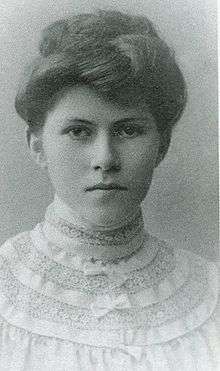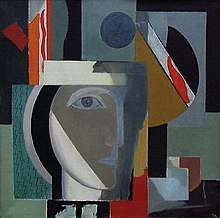Ragnhild Kaarbø
Ragnhild Kaarbø (26 December 1889 – 20 August 1949) was a Norwegian painter.[1]
Ragnhild Kaarbø | |
|---|---|
 Ragnhild Kaarbø c.1910 | |
| Born | 26 December 1889 Harstad, Norway |
| Died | 20 August 1949 (aged 59) |
| Nationality | Norwegian |
| Occupation | Painter |
| Parent(s) | Rikard Kaarbø |
| Relatives | Erland Frisvold (brother-in-law) Paal Frisvold (nephew) |
Personal life
She was born at Harstad in Troms, Norway. She was one of thirteen children born to Rikard Kaarbø and Anna Elisabeth Lund.[2] Her father was a successful businessman who was associated with the establishment of the town of Harstad. He founded several businesses and fostered development of the local shipping industry. [3]
Career
Kaarbø attended a boarding school in Celle, Germany and decided to pursue a career in art. She studied at the Norwegian National Academy of Craft and Art Industry in Kristiania (now Oslo), and further with Henrik Sørensen and Harriet Backer, and with expressionist Kees van Dongen in Paris. In 1918, she held her first solo exhibition in the Artists' Association in Kristiania (now Oslo).[4]
Between 1920 and 1930 she stayed mainly in Paris where she followed the teaching of several noted artists, including Andre Lhote and Pedro Araujo. Between 1925-1927 she was a student of Fernand Léger and Amédée Ozenfant at the Académie Modern. [5]

During her early years, Kaarbø was influenced by fauvism, and painted many expressive portraits of women. She then had a period when she mainly painted landscapes, both coastal landscapes and town motifs. In Paris in the 1920s she was influenced by cubism and other avant-garde styles. She participated at the exhibition Otte skandinaviske kubister ("Eight Scandinavian cubists") at Kunstnerforbundet in Oslo in 1926. The exhibition was met with great interest but mostly negative criticism, and Kunstnerforbundet was even boycotted by the press. Disappointed by the negative response, Kaarbø switched to painting landscapes in impressionist style.[2]
She participated in several exhibitions, including two works at the Salon d'automne in 1922 and attended the Exposition Académie Moderne Exhibition at the Gallery of Art Contemporain in 1926 and at the Exposition de l'Académie Moderne Léger Ozenfant in the Gallery Aubier in 1927. Among her works at the National Gallery of Norway are Komposisjon med hode from 1925 and Fra Siena from 1937.[2][6][7]
Kaarbø was included in the 2013 exhibition Electromagnetic: Modern Art in Northern Europe 1918-31 at the Henie Onstad Art Center.[8]
References
- "Ragnhild Kaarbø". Lokalhistoriewiki. Retrieved September 1, 2016.
- Mørch, Hilde. "Ragnhild Kaarbø". In Helle, Knut (ed.). Norsk biografisk leksikon (in Norwegian). Oslo: Kunnskapsforlaget. Retrieved 23 March 2016.
- Jon Gulowsen. "Rikard Kaarbø". Norsk biografisk leksikon. Retrieved September 1, 2016.
- Nina Skurtveit (July 8, 2013). "Pioneren Ragnhild Kaarbø". NRK. Retrieved December 1, 2017.
- Gjessing, Steinar. "Ragnhild Kaarbø". Norsk kunstnerleksikon (in Norwegian). Oslo: Nasjonalmuseet for kunst. Retrieved 23 March 2016.
- Godal, Anne Marit (ed.). "Ragnhild Kaarbø". Store norske leksikon (in Norwegian). Oslo: Norsk nettleksikon. Retrieved 23 March 2016.
- "Ragnhild Kaarbø". Nasjonalmuseet. Retrieved December 1, 2017.
- "Electromagnetic: Modern Art in Northern Europe 1918-31". MutualArt. Retrieved 19 January 2020.
External links
